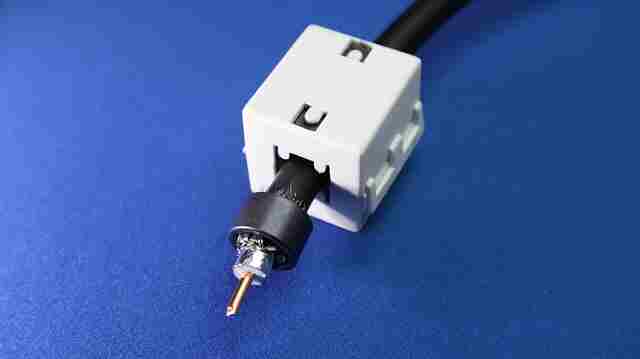What is Coaxical Cable | Computer Engineering
A coaxial cable consists of a central copper wire core, which is surrounded by an insulating material. The insulator is surrounded by braided metal shielding which helps to absorb external electronic signals (noise) and prevents it from interfering with the data signal. A plastic sheath protects the outer conductor. A durable plastic or Teflon jacket coats the cable to prevent damage. The construction and shielding of coaxial cable provide a high degree of noise immunity, and coaxial cable can be used over longer distances (up to 500 meters) than twisted pair cable. Coaxial cable runs are used to provide the network backbone cable segments in networks having a Bus Topology and require a terminating resistor at each end of the cable to prevent interference due to signal reflection.
Characteristics of Coaxial cable
It is highly resistant to EMI and can support high bandwidths. Some types of coaxial cables have heavy shields and center conductors to enhance these characteristics and extend the distances so that signals can be transmitted reliably. A wide variety of coaxial cable cables is available. You must use cable that exactly matches the requirements of a particular type of network. Coaxial cable cables vary in a measurement known as the impedance (measured in a unit called the ohm), which is an indication of the cable’s resistance to current flow. The specifications of a given cabling standard indicate the required impedance of the cable.
Two types of coaxial cable can be used in computer networks :
- Thinnet or Cheapernet (also known as Baseband Coax – RG-58)
- Thicknet
- Thinnet (10Base2) is so called because of the thin, inexpensive coaxial cabling it uses, and is fairly flexible, being 0.25 inches in diameter.
- The IEEE specification refers to this type of cable as 10Base2, referring to its main specifications of 10 Mbps data rate, baseband transmission type, and 185 (nearly 200) meter maximum segment length. The cable between computers must be at least 0.5 meters (20 inches) long.
- An IEEE standard for Thinnet doesn’t allow a drop cable to be used from the bus T-connector to a workstation. Instead, the T-connector fits directly onto the network adapter card using a BNC connector.
- A Thinnet Network can support a maximum of 30 nodes per cable segment, and up to five segments can be connected using repeaters, of which three segments may be populated, allowing up to 90 nodes to be supported (based on the IEEE 802.3 specification). Thicknet Cable (also known as Standard Ethernet) is relatively rigid, being 0.5 inches in diameter.
- The IEEE specification refers to this type of cable as 10Base5, referring to its main specifications of 10 Mbps data rate, baseband transmission type, and 500-metre maximum segment length.
- Thicknet is generally used to provide the network backbone and can support up to 100 nodes per backbone segment. The minimum cable length between connections (or taps) on a Thicknet cable segment is 2.5 meters (about 8 feet).
- Thicknet cable has a data rate of 10 Mbps and can carry a signal for 500 meters before a repeater is required. The grade of coaxial cable used will depend on where it is used.
- Normal PVC coaxial cable is flexible, easy to work with, and may be used in exposed areas of offices, but because it gives off poisonous fumes when it burns, it is against the fire regulations in many countries for it to be installed in floor and ceiling voids which are also used to allow air to circulate the building.
- Thick coax was the transmission medium originally used by Xerox for their Ethernet network, although it was later superseded by thin coax.
- Although still used in many networks, coaxial cable is gradually being replaced by fiber optic, and UTP cable fiber optic is normally used for the network backbone, with UTP being used to connect workstations to hubs or MAUs.
Here are some common examples of coaxial cables used in LANs, along with their impedances, and the LAN standards with which they are associated :
> RG-8 and RG-11 are 50-ohm cables required for thick-wire Ethernet. (10Base5 – ThikNet).
>RG-58 is a smaller 50-ohm cable required for use with thin-wire Ethernet. (10Base2 – ThinNet).
> RG-59 is a 75-ohm cable most familiar when used to wire cable TV. RG-59 is also used to cable broadband 802.3 Ethernet.
>RG-62 is a 93-ohm cable used for ARCnet. It is also commonly employed to wire terminals in an IBM SNA network.
The advantages of Coaxial Cable are as follows :
- Low cost due to less total footage of cable, hubs not needed.
- Lower attenuation than twisted pair.
- Good immunity to EMI/RFI / Highly insensitive to EMI.
- Supports high bandwidths.
- Heavier types of coax are sturdy and can withstand harsh environments.
- Represents a mature technology that is well understood and consistently applied among vendors.
- Disadvantages of Coaxial Cable are as follows :
- Limited network speed.
- Limited in size of network.
- One bad connector can take down entire network. Although fairly insensitive to EMI, coax remains vulnerable to EMI in harsh conditions such as factories.
- Coax can be bulky.
- Coax is among the most expensive types of wire cables.

